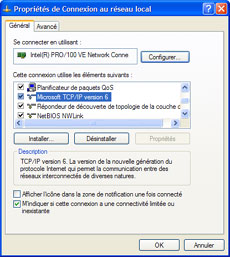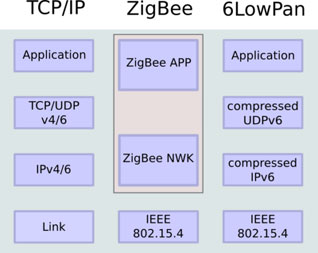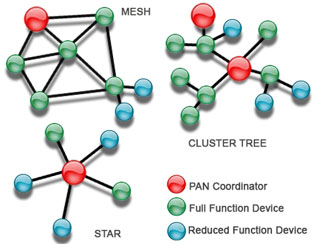MANET's have fully distributed communication capabilities in each device and can therefore work without any fixed infrastructore.
Other networks, both fixed and wireless require the installation and configuration of routers, access points etc before clients can connect and communicate over the network. A MANET device can act as both end-node and a router, and MANET devices uses protocols that enables them to announce their presence and configure themselves autonomously to form a network with other nodes within their radio communication distance. Therefore MANET's are very easily established.
MANET's are also robust since communication between nodes can take many paths, but they are limited to the extent that they require at least one link between all nodes in order to maintain the network. When all nodes are mobile there is no guarantee that the network is maintained continuously. This issue can be addressed by adding fixed nodes at strategic locations to prevent too long distances between any two mobile nodes.
The following sections describe some of the enabling technologies for MANET's.

IPv6
Internet protocol version 6 (IPv6) is the version of the internet protocol (IP) that is designed to replace version 4, which is the version of the protocol most dominant currently. The main driving force for designing IPv6 is the foreeable address exhaustion in v4. IPv4 uses a 32-bit address space, while it has been increased to 128 bits in IPv6. This means that IPv6 supports some 3,4*1038 unique addresses. That is 5*1028 addresses for every person on earth.
Autoconfiguration
IPv6 hosts can configure themselves automatically when connected to a routed IPv6 network. In IPv6 Internet Protocol Security (IPsec) has become mandatory. In v4 many fileds in the packet header are seldom used. These have been moved in IPv6 to separete option´s. This makes the header processing and packet forwarding much simpler for IPv6 routers.
Mobility
mobile IP is a sub-specification defining the ability for mobile hosts to migrate between different networks while maintaining a permanent IP-address. The IP-specifications for mobility in v4 made triangular routing possible. This has been eliminated in v6. mobile IPv6 is therefore as efficient as native IPv6. In addition mobile IPv6 also supports network mobility, allowing entire subnets to migrate to a new gateway router without address renumbering.
Option extensions
IPv6 implements options as additional extension headers after the basic IPv6 header. In Ipv4 the options are contained in a fixed size section in the basic header. The extension mechanism in the header enables future services such as quality of service, mobility and security to be added without the need to redesign the basic protocol.

IEEE 802.15.4
IEEE 802.15.4 is a standard specification defining the physical layer and the media access control for low-rate wireless personal area networks (LR-WPANs).
IEEE 802.15.4 defines the lower network layers for wireless personal area networks with low-cost, low-speed communication devices where little or no supporting infrastructure such as routers exist. The primary scope of the specification implies a ten meter communication range with a transfer rate of 250 kbit/s.
Some of the most important features in the specification are the reservation of time-slots, collision avoidance and functions to support good power management by devices.
IEEE 802.15.4 has been the basis for the ZigBee Alliance, WirelessHART and MiWi initiatives to offer a complete networking solution for low cost - low power devices.

6loWPAN
6lowpan is the name of a working group within Internet Engineering Task Force (IETF). The acronym was first spelled out as IPv6 over Low power Wireless Personal Area Networks, but since the "Personal" qualifier is no longer relevant it shall now be read IPv6 over LoW Power wireless Area Networks.
The base specification developed by the working group defines encapsulation and header compression mechanisms allowing IPv6 packets to be handled in IEEE 802.15.4 radio networks. 6lowpan is an alternative to the ZigBee Alliance, WirelessHART and MiWi initiatives to offer a complete networking solution for low cost -low power devices.

Zigbee
An alternate route to 6lowpan to provide a complete networking solution for small low-cost devices has been taken by a number of companies through the ZigBee Alliance. The ZigBee specification defines a suite of high level communication protocols for small, low-power digital radio devices.
The technology defined by the ZigBee specification is intended to be simpler and less expensive to implement than other WPAN's such as Bluetooth. ZigBee has different application target than Bluetooth, focusing on building automation, home automation, industrial control, embedded sensing, medical data collection, smoke and intruder warning.
A ZigBee network requires three different device-roles;
The ZigBee Coordinator
The ZigBee Coordinator (ZC) is responsible for the creation of a network and has the capability to bridge with othernetworks. It stores information about the network and manages the repository of security keys used in the network.
The ZigBee Router
A ZigBee Router (ZR) can run application functions and pass on data from other devices in the network.
The ZigBee End Device
A ZigBee End Device (ZED) cannot relay data from other devices. Its sole responsibility is to run its own functions and communicate with a ZR or ZC. Since communicationcan be limited to very short periods of time, a ZED can be asleep most of time, conserving scarce energy resources.
